Knee pain can be debilitating, affecting every aspect of life. For those suffering from chronic knee pain, finding an effective pain relief treatment is crucial. Traditional methods often involve medication or surgery, but there’s a promising alternative.
The genicular nerve block procedure has emerged as a minimally invasive solution, offering significant pain management benefits. By targeting specific nerves around the knee joint, this treatment interrupts pain signals to the brain, providing relief without compromising mobility.
This innovative procedure is gaining popularity for its effectiveness in addressing various knee conditions, making it a valuable option for those seeking alternatives to long-term medication or surgery.
Key Takeaways
- Genicular nerve block is a minimally invasive procedure for knee pain relief.
- It targets specific nerves around the knee joint to interrupt pain signals.
- This treatment preserves motor function, maintaining patient mobility.
- It’s an alternative to traditional pain management approaches.
- Effective for both acute and chronic knee pain conditions.
Understanding Genicular Nerve Block
For patients experiencing chronic knee pain, genicular nerve blocks offer a targeted approach to pain management. This procedure involves blocking the genicular nerves that transmit pain signals from the knee to the brain.
What Is a Genicular Nerve Block?
A genicular nerve block is a minimally invasive procedure where a local anesthetic and sometimes a steroid are injected around the nerves that supply the knee. This technique is particularly useful for managing pain associated with osteoarthritis and other knee conditions. By targeting the sensory nerves around the knee, genicular nerve blocks can provide effective relief without affecting the surrounding muscle strength.
The procedure is performed under ultrasound guidance to ensure accurate placement of the injections. According to recent studies, genicular nerve blocks may be a useful new technique for knee analgesia, preserving quadriceps muscle strength by targeting only sensory afferents from the knee joint.
How It Differs from Other Knee Pain Treatments
Genicular nerve blocks differ significantly from other treatments for knee pain. Unlike oral pain medications that have systemic effects, genicular nerve blocks provide localized relief. Compared to intra-articular injections that deliver medication into the knee joint, genicular nerve blocks target the nerves transmitting pain signals, potentially offering longer-lasting relief.
| Treatment | Target | Benefits |
|---|---|---|
| Genicular Nerve Blocks | Nerves around the knee | Targeted relief, preserves motor function |
| Oral Pain Medications | Systemic | Affects entire body, potential side effects |
| Intra-articular Injections | Knee joint | Temporary relief, potential for joint damage |
For more detailed information on genicular nerve blocks and their application, you can visit this resource, which provides comprehensive insights into the procedure and its benefits for patients with chronic knee pain, including those with osteoarthritis.
Anatomy of the Knee and Genicular Nerves
Understanding the anatomy of the knee and its associated genicular nerves is crucial for appreciating the effectiveness of genicular nerve blocks. The knee joint is a complex structure involving bones, ligaments, tendons, and a network of nerves that transmit pain signals.
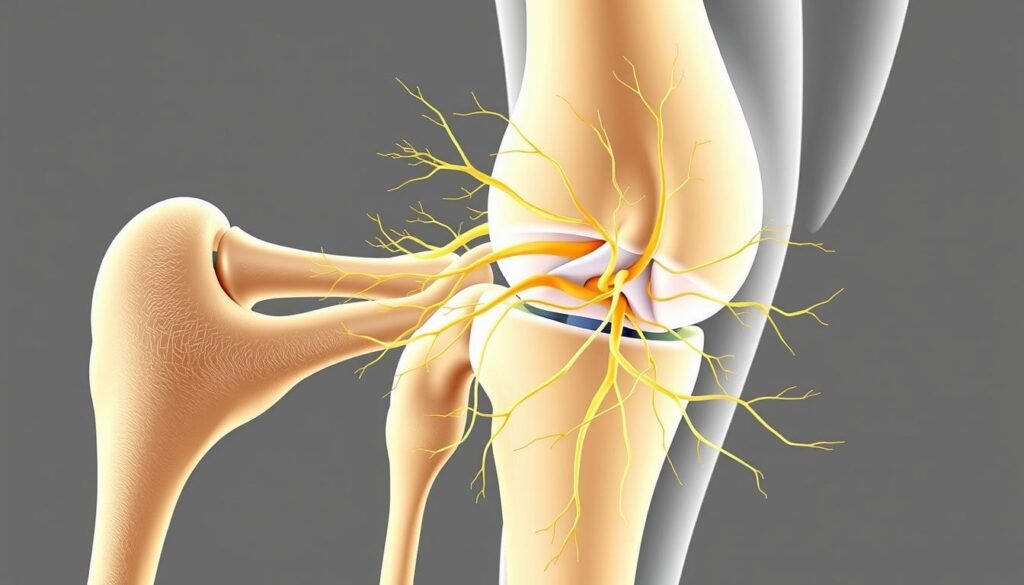
The Genicular Nerve Network
The genicular nerve network surrounds the knee, providing sensory innervation to the joint capsule and surrounding tissues. This network is composed of several branches that arise from larger nerves, including the femoral, tibial, and common peroneal nerves. The genicular nerves play a crucial role in transmitting pain signals from the knee to the brain.
Key Nerve Branches Targeted During the Procedure
During a genicular nerve block procedure, specific branches of the genicular nerves are targeted to interrupt pain signals to the brain. The primary branches targeted include the superolateral genicular nerve (SLGN), the superomedial genicular nerve (SMGN), and the inferomedial genicular nerve (IMGN). These branches are responsible for innervating different aspects of the knee joint.
| Nerve Branch | Origin | Area Innervated |
|---|---|---|
| SLGN | Common peroneal nerve | Anterolateral knee joint capsule |
| SMGN | Tibial nerve | Anteromedial aspect of the knee joint |
| IMGN | Tibial nerve | Medial aspect of the knee joint |
The precise targeting of these nerve branches during a block procedure is what makes genicular nerve blocks an effective treatment for chronic knee pain.
When Is a Genicular Nerve Block Recommended?
Genicular nerve blocks have emerged as a valuable treatment option for patients suffering from knee pain, particularly those with knee osteoarthritis. This procedure is considered when conservative management strategies fail to provide adequate relief.
Conditions That Respond Well to the Procedure
The genicular nerve block is particularly effective for patients with osteoarthritis of the knee. Osteoarthritis is a degenerative joint disease that causes pain and stiffness, significantly impacting the quality of life. Patients who experience persistent knee pain despite trying various conservative treatments such as physical therapy and oral medications are ideal candidates for this procedure.
Who Makes an Ideal Candidate
Ideal candidates for genicular nerve blocks include those with confirmed knee osteoarthritis who experience significant pain. Specifically, this includes:
- Patients who have not responded to conservative treatments like physical therapy and oral medications.
- Individuals who cannot tolerate or have contraindications to oral pain medications, such as those with gastrointestinal issues or kidney problems.
- Those who wish to avoid or delay knee replacement surgery but need effective pain relief to maintain their quality of life and functional ability.
- Patients with chronic knee pain who have shown a positive response to diagnostic nerve blocks.
- Elderly patients or those with multiple comorbidities who may not be suitable candidates for surgery.
By targeting the genicular nerves, this procedure offers a less invasive alternative for managing pain associated with osteoarthritis and other knee conditions.
The Science Behind Genicular Nerve Block
The genicular nerve block procedure has garnered significant attention for its efficacy in managing knee pain, and understanding its scientific basis is crucial for appreciating its benefits. This procedure involves the injection of local anesthetics and sometimes corticosteroids around the genicular nerves that supply the knee.
How Local Anesthetics Work on Nerve Pathways
Local anesthetics work by blocking the transmission of pain signals from the knee to the brain. They achieve this by inhibiting the influx of sodium ions into the nerve cells, thereby preventing the depolarization of the nerve membrane and the subsequent transmission of pain signals. The use of local anesthetics in genicular nerve blocks has been shown to provide effective pain relief by interrupting these pain pathways.
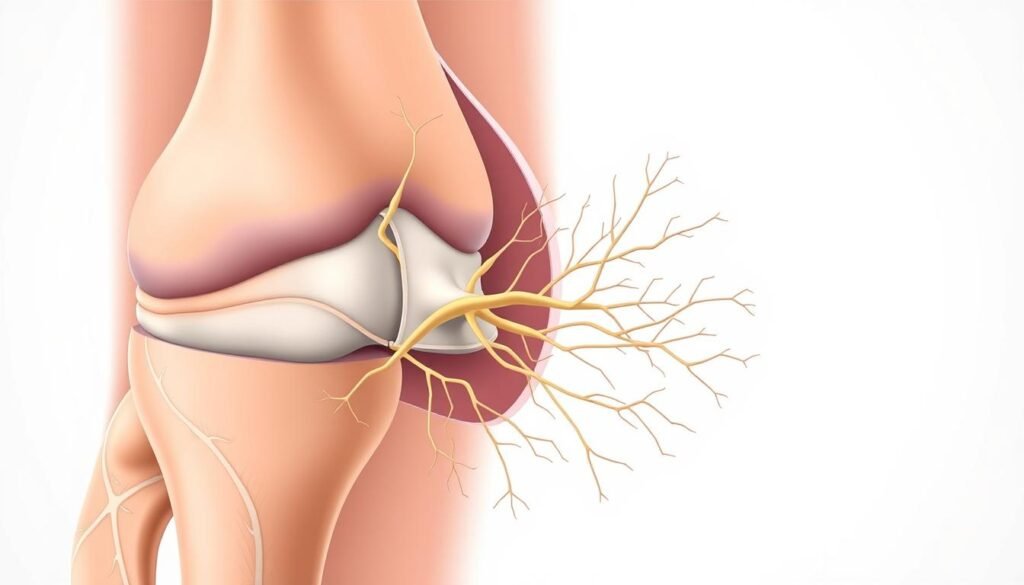
Duration and Extent of Pain Relief
The duration of pain relief following a genicular nerve block can vary significantly depending on whether the procedure is performed for diagnostic or therapeutic purposes. Diagnostic blocks typically provide relief for a shorter duration, often lasting hours to days. In contrast, therapeutic genicular nerve blocks that include corticosteroids can offer pain relief lasting from several weeks to months, with some patients experiencing benefits for up to 3-6 months after a single procedure.
| Outcome Measure | Total Effect | P-Value | I2 Value |
|---|---|---|---|
| Pain Reduction at 1 and 3 Months | 1.43 (95% CI, 0.86, 1.99) | 0.00001 | 85% |
| Knee Function Improvement at 1 and 3 Months | 0.71 (95% CI, 0.35, 1.06) | 0.00001 | 69% |
Clinical studies have demonstrated statistically significant pain reduction at both 1 and 3 months following genicular nerve blocks, with many patients experiencing a 50% or greater reduction in pain scores. For more detailed information on the clinical evidence supporting genicular nerve blocks, you can refer to studies published on PMC.
Step-by-Step Genicular Nerve Block Procedure
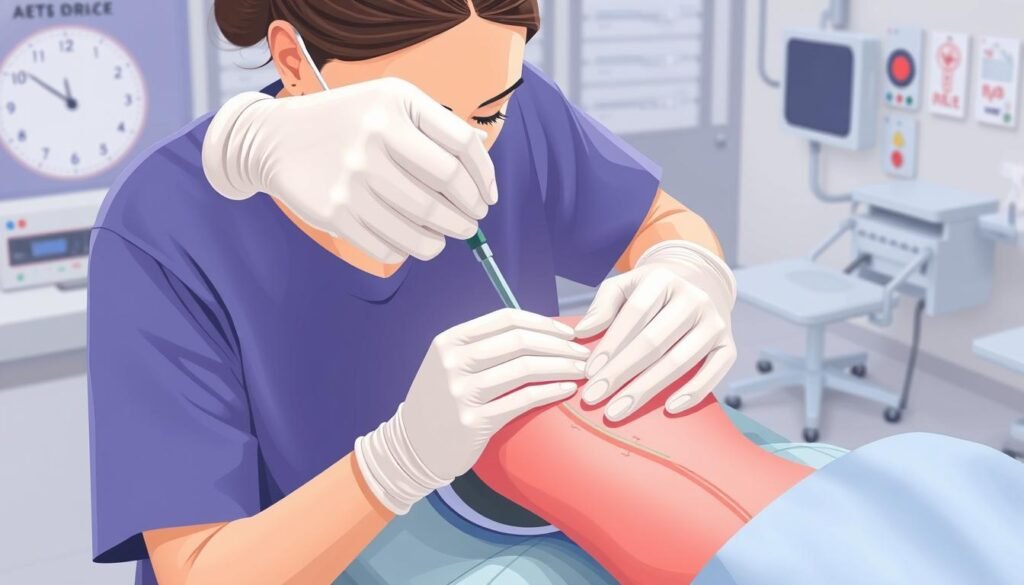
For individuals suffering from chronic knee pain, understanding the genicular nerve block procedure is crucial. This procedure involves a series of steps that are designed to provide relief from pain by blocking the genicular nerves.
Pre-Procedure Preparation
Before undergoing a genicular nerve block, preparation is key. This includes a thorough medical evaluation to determine the suitability of the procedure for the patient. Patients are typically advised on the necessary precautions and the expected outcomes.
Positioning and Equipment
The genicular nerve block is performed with the patient in a comfortable position, usually supine, with the knee slightly flexed. The equipment used includes an ultrasound machine and a needle, typically 22-25 gauge, for the injection of local anesthetic.
Ultrasound Guidance Technique
The technique involves using ultrasound guidance to accurately locate the genicular nerves. The transducer is placed on the skin over the target area, and the needle is advanced under continuous ultrasound visualization to ensure precise placement.
Injection Process for Each Target Nerve
The injection process begins with the identification of the appropriate anatomical landmarks using ultrasound. For each target nerve, a local anesthetic is injected near the nerve location. The process involves aspiration before injection to avoid intravascular administration. This step is repeated for each of the three primary target nerves.
The entire procedure typically takes 15-30 minutes to complete, depending on the complexity and the patient’s anatomy. By following this step-by-step genicular nerve block technique, healthcare providers can offer significant pain relief to patients suffering from chronic knee pain.
Types of Genicular Nerve Blocks
Genicular nerve blocks are categorized into different types based on their purpose and the technique used. This categorization helps in tailoring the treatment to the specific needs of patients suffering from knee pain.
Diagnostic Blocks vs. Therapeutic Blocks
Genicular nerve blocks can be broadly classified into diagnostic blocks and therapeutic blocks. Diagnostic blocks are used to determine if the genicular nerves are the source of pain, while therapeutic blocks aim to provide relief from pain. Diagnostic blocks involve injecting a local anesthetic to temporarily numb the area, helping to identify the pain source. Therapeutic blocks, on the other hand, may involve the use of corticosteroids or other agents to provide longer-term pain relief.
- Diagnostic blocks help in identifying the pain source.
- Therapeutic blocks provide relief from pain.
Radiofrequency Ablation as an Alternative
Radiofrequency ablation (RFA) is an alternative to traditional genicular nerve blocks. It involves applying extreme heat or cold to the genicular nerves to interrupt pain signal transmission. Studies, such as a 2011 randomized controlled trial by Choi and colleagues, have shown that RFA can be effective in treating osteoarthritic knee joint pain. RFA targets the same genicular nerve branches as nerve blocks but uses specialized needles to deliver controlled thermal energy, modifying nerve function and providing pain relief that can last 6-12 months or longer.
The benefits of RFA include its long-lasting effects and the potential to reduce reliance on pain medications. As with any procedure, it’s essential to consult with a healthcare professional to determine if RFA is the right option for your specific condition.
Benefits of Genicular Nerve Block
One of the most significant advantages of genicular nerve block is its ability to provide long-lasting pain relief. This procedure has been shown to be safe and effective for achieving durable, motor-sparing, and opioid-sparing analgesia.
Immediate Pain Relief Benefits
Patients who undergo genicular nerve block often experience immediate pain relief. This is particularly beneficial for individuals suffering from chronic knee pain due to osteoarthritis or other degenerative conditions. By targeting the genicular nerves, the procedure interrupts pain signals to the brain, providing quick and effective relief.
Preservation of Motor Function
Unlike some other pain management treatments, genicular nerve block preserves motor function. This means that patients can continue with their daily activities without significant impairment. The procedure’s precision in targeting pain pathways while sparing motor nerves is a significant advantage.
Reduced Need for Opioid Medications
Genicular nerve block can significantly reduce or eliminate the need for opioid pain medications. By providing effective pain relief through a localized procedure, patients can avoid the risks associated with opioid use, such as dependence, tolerance, and side effects. Studies have shown that patients who undergo genicular nerve blocks report decreased consumption of both prescription and over-the-counter pain medications.
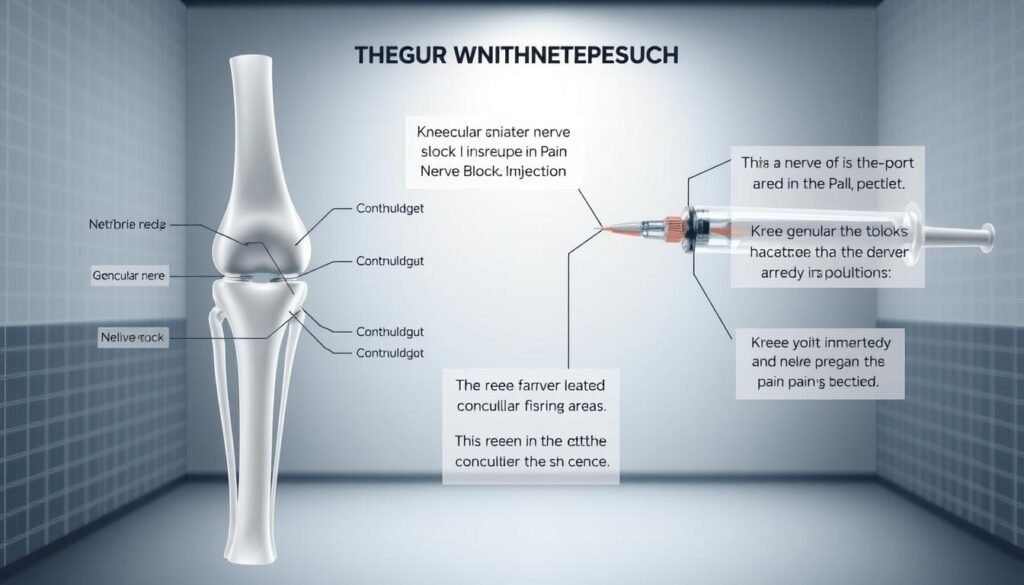
The benefits of genicular nerve block are multifaceted, offering patients a comprehensive solution for managing knee pain. By providing immediate pain relief, preserving motor function, and reducing the need for opioid medications, this procedure represents a valuable treatment option for those suffering from chronic knee pain.
Potential Risks and Side Effects
Understanding the potential risks and side effects of genicular nerve block is essential for informed decision-making. While the procedure is generally considered safe, it’s not without its complications.
Common Side Effects
Common side effects associated with genicular nerve block include temporary numbness or weakness in the knee area due to the injection of local anesthetics. Some patients may experience mild pain or discomfort at the injection site. These side effects are typically short-lived and resolve on their own.
Rare Complications
Rare but potential complications of genicular nerve block include infection at the injection site, allergic reactions to the medications used, and nerve damage. Although rare, these complications can result in significant symptoms that require medical attention.
When to Seek Medical Attention
It’s crucial for patients to be aware of the signs that necessitate seeking immediate medical care. These include:
- Severe or worsening pain that differs significantly from the baseline knee pain.
- Signs of infection such as redness, warmth, swelling, or discharge at the injection sites.
- Persistent numbness, tingling, or weakness beyond the expected duration.
- Systemic symptoms like fever, chills, or rash.
- Difficulty walking or significant instability.
Being aware of these potentialrisksandside effectscan help patients make informed decisions about their treatment.
Clinical Evidence and Effectiveness
The clinical effectiveness of genicular nerve blocks is supported by a body of research examining pain reduction outcomes. This procedure has been studied extensively to understand its efficacy in managing knee pain, particularly for patients with osteoarthritis.
Research on Pain Reduction Outcomes
Recent randomized controlled trials have provided valuable insights into the pain relief offered by genicular nerve blocks. For instance, a 2021 trial involving 64 participants with knee osteoarthritis reported significant pain improvement in those who received genicular nerve blocks, comparable to those who received intra-articular steroid (IAS) injections. The study used sonography of large joints in Rheumatology (SOLAR) scoring, Visual Analog Scale (VAS), and Lysholm score to assess outcomes over a 12-week follow-up period.
The results of such studies contribute to the growing evidence supporting the use of genicular nerve blocks as an effective pain management strategy. With efficacy in reducing pain, this procedure offers a valuable option for patients seeking relief from knee pain.
Comparison with Other Treatment Options
Comparative studies have been conducted to evaluate the effectiveness of genicular nerve blocks against other treatment modalities. These studies have shown that genicular nerve blocks provide similar short-term pain relief compared to intra-articular steroid injections, with some suggesting longer-lasting benefits. When compared to oral analgesics, genicular nerve blocks offer targeted pain relief without systemic side effects, although they require a procedural intervention.
- Genicular nerve blocks and radiofrequency ablation both provide significant pain relief, with the latter typically offering a longer duration of effect.
- The combination of genicular nerve blocks and physical therapy may yield superior outcomes compared to either treatment alone.
- For patients who are not candidates for knee replacement surgery or wish to delay it, genicular nerve blocks present a valuable non-surgical alternative.
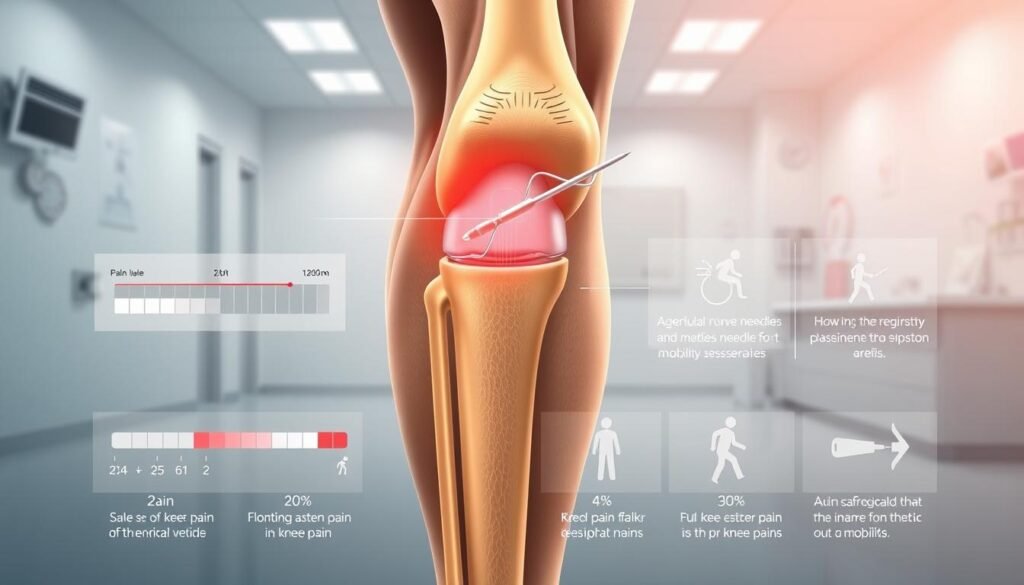
The comparison of genicular nerve blocks with other treatments highlights its potential as a versatile and effective treatment option for knee pain management.
Recovery and Post-Procedure Care
Post-procedure care is an essential component of the genicular nerve block treatment, influencing both short-term and long-term outcomes. Effective management during this phase can significantly impact the duration and extent of pain relief achieved through the procedure.
What to Expect Immediately After the Procedure
Immediately after the genicular nerve block procedure, patients are typically monitored for a short period to assess any immediate reactions or side effects. It is common to experience numbness or weakness in the treated area, which usually resolves within a few hours. Patients are advised to have someone accompany them home due to potential temporary motor weakness or numbness.
Activity Restrictions and Recommendations
While specific activity restrictions may vary based on individual patient factors and the physician’s recommendations, generally, patients are advised to avoid strenuous activities for at least 24 hours following the procedure. Gradual resumption of normal activities is recommended, with a focus on low-impact exercises to maintain joint mobility without exacerbating the condition.
Follow-up Care and Additional Treatments
Follow-up appointments are crucial for assessing the effectiveness of the genicular nerve block and determining the need for additional treatments. As indicated in clinical studies, at the 6-month evaluation, patients who received cooled radiofrequency ablation (CRFA) showed significant improvements in WOMAC scores compared to those treated with intra-articular hyaluronic acid.
| Treatment | 6-Month WOMAC Score |
|---|---|
| CRFA | 33.6 |
| Intra-articular Hyaluronic Acid | 53.6 |
Long-term management plans are developed based on individual response to the initial block, with options including periodic repeat blocks, radiofrequency ablation for longer-lasting relief, or consideration of more definitive interventions like joint replacement for progressive joint deterioration. Comprehensive pain management often includes complementary treatments such as physical therapy and weight management to maximize functional improvement.
Conclusion
Genicular nerve blocks represent a minimally invasive treatment option that has shown potential in alleviating knee pain associated with osteoarthritis. This procedure targets the specific nerves transmitting pain signals from the knee joint, offering significant relief while preserving motor function. Although evidence is fair on genicular nerve blocks for primary knee osteoarthritis due to study heterogeneity and limited follow-up, the procedure’s safety profile and potential to reduce reliance on opioid medications make it an attractive treatment option. For patients with chronic knee osteoarthritis, genicular nerve blocks can improve mobility and quality of life. Ongoing research is needed to refine patient selection criteria and optimize long-term outcomes. As part of a comprehensive treatment approach, genicular nerve blocks may be considered alongside physical therapy, exercise, and weight management. For more information on non-surgical options for knee pain, visit our resource page.

